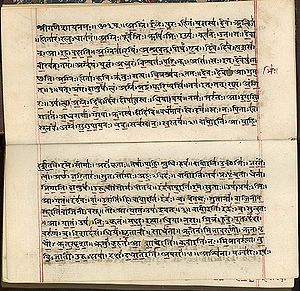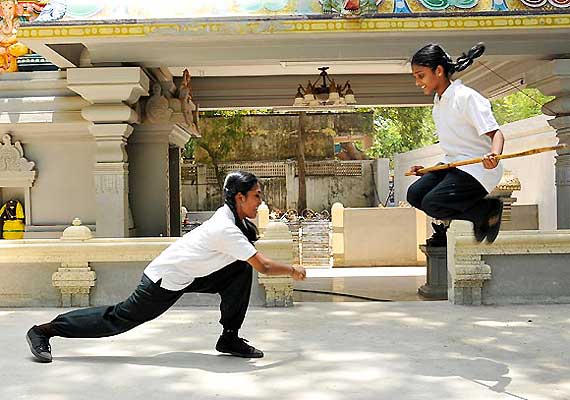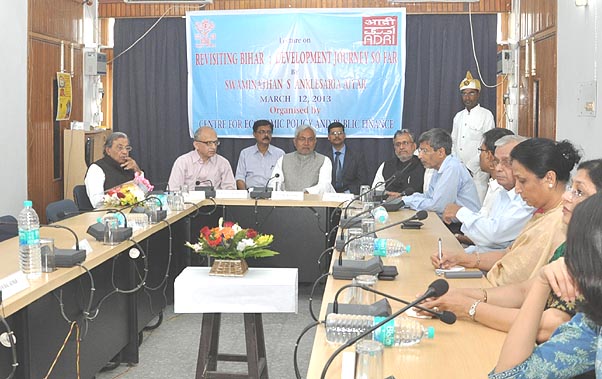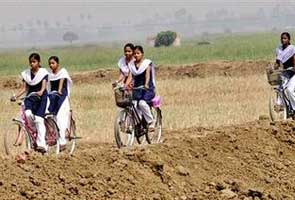The IIM sabziwala
The
face of Bihar is changing! While Chief Minister Nitish Kumar and the
political stability, now evident in Bihar, are at the forefront of the
change, young Bihari entrepreneurs with degrees from the Indian
Institutes of Management and Indian Institutes of Technology are using
their knowledge and special skills to transform rural life. Social
sector investment bankers are providing financial backing needed for any
meaningful transformation
in rural India.
When
Kaushlendra Kumar did his MBA from the IIM, Ahmedabad, and won a gold
medal and topped in agribusiness in 2007, he was confident of turning
his dream of making his home state Bihar, blessed with the rich alluvial
soil of the Ganga river, the vegetable capital of the country. While
his colleagues from the IIM were marketing toothpastes, noodles and
detergents for the multinationals, Kaushalendra set up Kaushalya
Foundation and stuck to marketing nutritious but humble vegetables.

Women, who were
confined to their homes, are now involved in sorting, grading and
packaging of vegetables at the processing centres. They earn anything
from Rs 1,500 to Rs 3,000 each per month |
The
vegetable supply chain venture was so novel that the faculty at his alma
mater and friends helped him design a light vegetable cart that could
be pushed or attached to a cycle as well the technology that would
enable him to increase the shelf-life of the vegetables through the
summer heat. Initially, he even pushed his own cart to gauge public
response and study the demands and gaps in his knowledge and marketing.
And soon enough, Kaushalendra was nicknamed the IIM sabziwala.
The
nickname has stayed but the business of the vegetable-supply chain
called Samriddhii has grown. It has yielded dividends for farmers who
have joined his vegetable network, increased employment for women and
won laurels for Kaushlendra and his Kaushalya Foundation.
Today,
more than 3,000 farmers in Patna and Nalanda districts are growing and
selling eight to nine tonnes of vegetables through the Samriddhii supply
chain and their incomes have soared. While importance is given to
cultivation of traditional vegetables like green brinjals, parwal or
snake gourd and seasonal vegetables, growth of exotic vegetables like
mushrooms, baby corn and special varieties of tomatoes in green houses,
is also catching on. Broccoli and other exotic vegetables can also be
grown but in the absence of five-stars hotels in Bihar, it is not yet an
economically viable option, says Anuj Kumar, 28, one of the five MBAs
associated with the Kaushalya Foundation
While his
colleagues from the IIM were marketing toothpastes, noodles and
detergents for the multinationals, Kaushalendra set up Kaushalya
Foundation and stuck to marketing vegetables
|
Farmers
are being organised to work together as a collective unit. If a group
of 25 to 30 farmers in a village come together, a vegetable collection
centre is set up in the village or its vicinity. These centres are
managed by the farmers themselves and they get paid an additional 10
paise per kilo of vegetable that comes to the centre. The Kaushalya
Foundation, however, keeps a benevolent eye, advising and solving
problems if needed. The collection centres save the farmers the long
trudge to the mandis with sack-loads of vegetables weighing 50 to 60 kg.
So far, eight collection centres or Samriddhii grameen kendras have
been set up in Patna and Nalanda districts. The vegetables are then
taken by tempos to processing centres, where theseare cleaned, graded
and separated according to their quality before being packed and
dispatched for distribution.
Vegetables
are cleaned but not washed because soaking them in water decreases
shelf life, says Anuj Kumar. The prices of the Samriddhii vegetables
vary according to their quality. While the ‘B’ grade vegetables, used by
bulk consumers like hotels and restaurants, are cheap, the ‘A’ grade
vegetables, retailed through air-conditioned outlets to customers
finicky about quality, are more expensive. Vegetables like potatoes,
onions, tomatoes sold to bulk consumers are also big in size because
they are easier to peel and chop and there is less wastage. The ‘C’ and
‘D’ grade vegetables sold to dhabas and wayside shops are the cheapest
and have to be consumed quickly. If the A grade potato costs Rs 8 a kg, B
grade would cost Rs 6 and C and D grade Rs 4 to Rs 3 a kg,
respectively. Samriddhii also has pre-paid card facility to sell
pesticide-free vegetables.

The faculty at
his alma mater and friends helped Kaushlendra design a light vegetable
cart that could be pushed or attached to a cycle. The technology-driven
cart also has a cooling system – chemicals that convert into ice so that
the vegetables stay fresh for five hours |
Kaushalya Foundation’s objective
*
To connect vendors and marginalised growers to the mainstream of the society
* To provide a platform and support to vendors and marginalised growers in the evolving economy
* To prepare vendors and marginalised growers for new market challenges
* Creating infrastructure
* Strengthening the link between growers and vendors
* Reducing the operational cost and increasing price realisation for vendors & growers.
* Providing added benefits to the vendors & growers
like insurance cover for family and free education to wards.
The Kaushalya Foundation owns one tempo and hires other vehicles as per requirement.
The
farmers have an assured market in the collection centres. They are
informed about the purchase price of all vegetables the previous night
and if the price does not suit them, they can defer the sale or take
their crop to the traditional mandi. However, selling to the Samriddhii
kendras saves farmers the cost of transportation, weighing and packaging
charges and the commission that mandis charge. The income of farmers,
who have joined Samriddhii’s vegetable supply chain, has gone up from
0.25 to 1.50 times.
As
members of the Samriddhii family, the farmers are trained in organic
farming, taken on study tours and encouraged and supported for growing
exotic vegetables like baby corn and mushrooms in low-cost green houses
or poly-houses (polythene sheets spread over bamboo poles).
This
year the Kaushalya Foundation is entering into an MoU with the
Agriculture Department, Bihar, for subsidy for the cultivation of baby
corn. Also proposed is one poly-house in each village at government
cost. Last year, the Kaushalya Foundation constructed five poly-houses
at its own expense — three in Patna and two in Nalanda, the hometown of
Kaushalendra, Anuj, and of course, Chief Minister Nitish Kumar.
Farmers are being
organised to work together as a collective unit. If a group of 25 to 30
farmers in a village come together, a vegetable collection centre is
set up in the village or
its vicinity
|
There
are 50 vegetable carts in Patna on the lines of the first designed in
2007. The new vegetable carts, attached to cycles and with better
display and space for advertisements, are an improvement on the first
prototype. The 60-kg carts have a five-year life and if these are able
to get ads, it can pay the Rs 52,000 cost of the cart. Recently, the
Bihar Government announced a subsidy of Rs 27,000 on these carts. The
technology-driven cart also has a cooling system – chemicals that
convert into ice so that the vegetables stay fresh for five hours.
The
neatly packed and graded vegetables, carrying the Samriddhii logo are
bar coded so that the buyer knows the name of the village from which
they come from, their price and weight.
With
the entry of the Kaushalya Foundation, there has been a spurt in
employment in the farm sector, especially for women. Women, who were
confined to their homes, are now involved in sorting, grading and
packaging of vegetables at the processing centres and earn anything from
Rs 1,500 to Rs 3,000 per month. However, the women need to know how to
use electronic machines for weighing, packaging
etc. Poly-houses are also being given
in the name of responsible and capable women farmers. Anuj Kumar says
the farmers of Bihar, because of their poverty, were not using much
fertilisers and insecticides, so the soil is still very good. In
addition, the ebb and flow of the Ganga ensure that the soil is
rejuvenated annually. In the poly-houses coming up in rural Bihar, too,
no insecticides and pesticides are used, and only the minimum chemical
fertilisers are allowed. The vegetables, grown in the poly-houses, are
priced higher and are available on demand. The order for the
poly-house-grown vegetables have to be placed in advance at the
processing centres.
While
Kaushlendra, 31, and Anuj are shareholders and do not draw a salary, the
other three MBAs attached with the Kaushalya Foundation are salaried
employees heading different units like new ventures, project management
etc.
“We
have put our heart, soul and money into Samriddhii,” says Anuj. “We are
single, have no family responsibility, and so, can work till late at
night and do without monetary benefits at this stage. Recently,
Kaushlendra’s elder brother, Dhirendra, has joined the business and he
meets farmers, organises groups and looks after procurement.

Navin Ranbir Gautam (left) and Dhirendra Kumar checking vegetables for their quality |
“Beginning
with a bank loan of Rs 50 lakh for capital expenditure and working
capital, for three years we were running at a loss. This year we have
made a small profit,” adds Anuj. “And it is being reinvested in the
business,” he says.
“The
bank loan is also being paid off every month. In the next five years,
the Kaushalya Foundation has set itself the goal of raising farmers’
incomes by 50 per cent. It is going to benefit us also, because once the
farmers start getting better prices, they’ll be in a position to
produce vegetables in a better way,” says
Anuj.
The
recognition and rewards are their sustenance. This year the organisation
received the Sankalp award from Aavishkar and Intelecap, social sector
investors. In 2010, the Willgro Award was given in Chennai. The
Kaushalya Foundation has also been short-listed for the Canadian Katerva
award for social enterprise and the UN Habitat Youth Fund. The May 2011
issue of the Time magazine also featured the Samriddhii venture in its
business story on grassroots entrepreneurs in rural India — reducing the
gap between rising India and the other India. It quotes one of
Samriddhii’s farmers, Gulab Singh of Yusufpur, who has been able to sell
tomatoes cultivated in his poly-house and now earns Rs 600 a day as
against Rs 120 just a couple of years ago.
The
Samriddhii model is obviously working. This January it has moved into UP
where it will working in a 50/50 partnership with a local entrepreneur –
ORVEM (Organised Vegetable Marketing).
Hoping
that Bihar can join the India economic miracle through its farms, Anuj
says the state has the potential to feed the whole country with
vegetables. Hopefully, it will provide the alternative model to
industrialisation.

(Left) The May
2011 issue of the Time magazine also featured the Samriddhii venture in
its business story on grassroots entrepreneurs in rural India
(middle) Dhirendra Kumar, Anuj Kumar, Kaushlendra,
Navin Ranbir Gautam and
H. K. Patel are the five MBAs working with the
Kaushalya Foundation
Photos courtesy: The Kaushalya Foundation (right) This year the foundation received the Sankalp award from Aavishkar and Intelecap, social sector investors
source:The TribuneSaturday, June 25, 2011 |






















